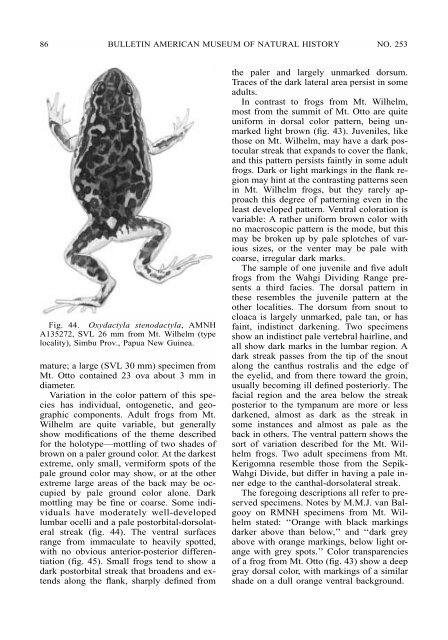SPHENOPHRYNE - American Museum of Natural History
SPHENOPHRYNE - American Museum of Natural History
SPHENOPHRYNE - American Museum of Natural History
You also want an ePaper? Increase the reach of your titles
YUMPU automatically turns print PDFs into web optimized ePapers that Google loves.
86 BULLETIN AMERICAN MUSEUM OF NATURAL HISTORY NO. 253<br />
Fig. 44. Oxydactyla stenodactyla, AMNH<br />
A135272, SVL 26 mm from Mt. Wilhelm (type<br />
locality), Simbu Prov., Papua New Guinea.<br />
mature; a large (SVL 30 mm) specimen from<br />
Mt. Otto contained 23 ova about 3 mm in<br />
diameter.<br />
Variation in the color pattern <strong>of</strong> this species<br />
has individual, ontogenetic, and geographic<br />
components. Adult frogs from Mt.<br />
Wilhelm are quite variable, but generally<br />
show modifications <strong>of</strong> the theme described<br />
for the holotype—mottling <strong>of</strong> two shades <strong>of</strong><br />
brown on a paler ground color. At the darkest<br />
extreme, only small, vermiform spots <strong>of</strong> the<br />
pale ground color may show, or at the other<br />
extreme large areas <strong>of</strong> the back may be occupied<br />
by pale ground color alone. Dark<br />
mottling may be fine or coarse. Some individuals<br />
have moderately well-developed<br />
lumbar ocelli and a pale postorbital-dorsolateral<br />
streak (fig. 44). The ventral surfaces<br />
range from immaculate to heavily spotted,<br />
with no obvious anterior-posterior differentiation<br />
(fig. 45). Small frogs tend to show a<br />
dark postorbital streak that broadens and extends<br />
along the flank, sharply defined from<br />
the paler and largely unmarked dorsum.<br />
Traces <strong>of</strong> the dark lateral area persist in some<br />
adults.<br />
In contrast to frogs from Mt. Wilhelm,<br />
most from the summit <strong>of</strong> Mt. Otto are quite<br />
uniform in dorsal color pattern, being unmarked<br />
light brown (fig. 43). Juveniles, like<br />
those on Mt. Wilhelm, may have a dark postocular<br />
streak that expands to cover the flank,<br />
and this pattern persists faintly in some adult<br />
frogs. Dark or light markings in the flank region<br />
may hint at the contrasting patterns seen<br />
in Mt. Wilhelm frogs, but they rarely approach<br />
this degree <strong>of</strong> patterning even in the<br />
least developed pattern. Ventral coloration is<br />
variable: A rather uniform brown color with<br />
no macroscopic pattern is the mode, but this<br />
may be broken up by pale splotches <strong>of</strong> various<br />
sizes, or the venter may be pale with<br />
coarse, irregular dark marks.<br />
The sample <strong>of</strong> one juvenile and five adult<br />
frogs from the Wahgi Dividing Range presents<br />
a third facies. The dorsal pattern in<br />
these resembles the juvenile pattern at the<br />
other localities. The dorsum from snout to<br />
cloaca is largely unmarked, pale tan, or has<br />
faint, indistinct darkening. Two specimens<br />
show an indistinct pale vertebral hairline, and<br />
all show dark marks in the lumbar region. A<br />
dark streak passes from the tip <strong>of</strong> the snout<br />
along the canthus rostralis and the edge <strong>of</strong><br />
the eyelid, and from there toward the groin,<br />
usually becoming ill defined posteriorly. The<br />
facial region and the area below the streak<br />
posterior to the tympanum are more or less<br />
darkened, almost as dark as the streak in<br />
some instances and almost as pale as the<br />
back in others. The ventral pattern shows the<br />
sort <strong>of</strong> variation described for the Mt. Wilhelm<br />
frogs. Two adult specimens from Mt.<br />
Kerigomna resemble those from the Sepik-<br />
Wahgi Divide, but differ in having a pale inner<br />
edge to the canthal-dorsolateral streak.<br />
The foregoing descriptions all refer to preserved<br />
specimens. Notes by M.M.J. van Balgooy<br />
on RMNH specimens from Mt. Wilhelm<br />
stated: ‘‘Orange with black markings<br />
darker above than below,’’ and ‘‘dark grey<br />
above with orange markings, below light orange<br />
with grey spots.’’ Color transparencies<br />
<strong>of</strong> a frog from Mt. Otto (fig. 43) show a deep<br />
gray dorsal color, with markings <strong>of</strong> a similar<br />
shade on a dull orange ventral background.
















